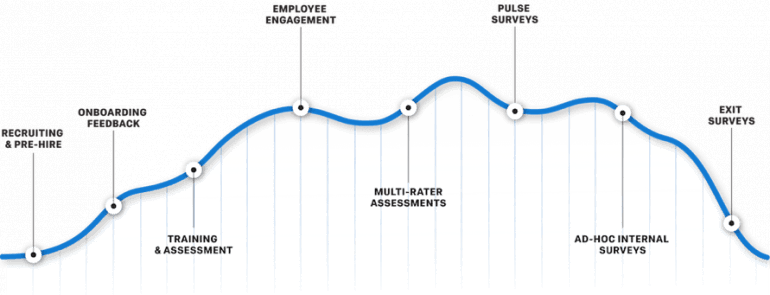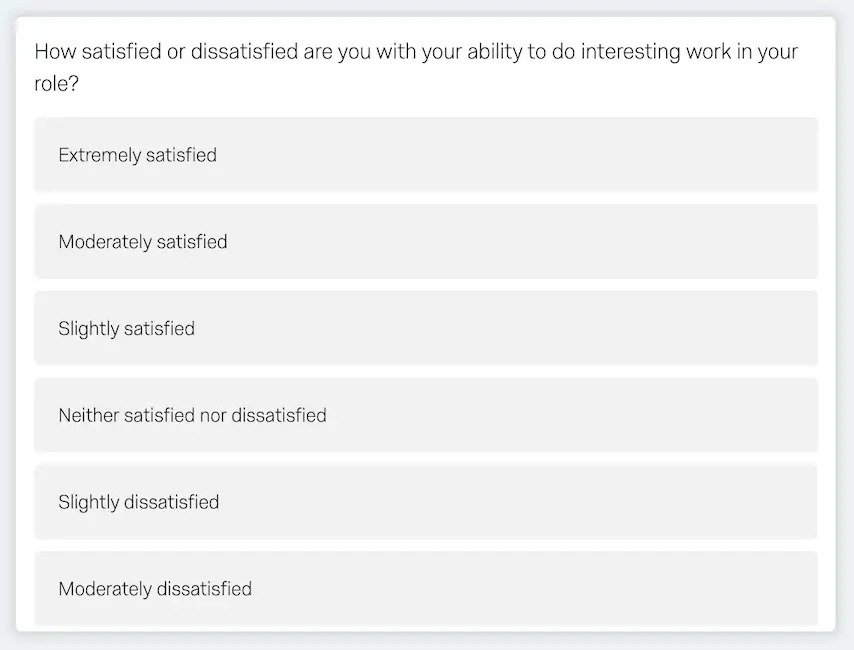
When it comes to measuring job, work-life balance, or employee satisfaction, surveys are a powerful solution. All the resources you need to succeed are here in our guide — use them strategically to unlock deep insights into the experience of your staff that will help employee retention, boost performance, and nurture the company’s culture. Let's look at the best practices and sample employee survey questions below. Get started with our free employee satisfaction survey template
An employee satisfaction survey, also called a job satisfaction survey, is an employee feedback tool that allows employers to find out about the employee experience, directly from employees themselves. Until recently, an employee opinion survey was typically a major annual event. But employers now recognize that to capture and improve the full employee experience — which goes beyond employee satisfaction and engagement — requires gathering data in various forms and at various points in the employee lifecycle. For much of this measurement, ESAT survey questionnaires are the perfect tool. Employee satisfaction survey questionnaires can be long, short, in-depth, or in the moment, and they provide a standardized framework that employers can use to measure and track how engaged at work employees are over time.
Reducing turnover and improving employee satisfaction has been a goal of organizations since at least the 1930s, when psychologists began earnestly studying employee attitudes and productivity, and how they were affected by the employer-employee relationship. At this time, a “job satisfaction” employee survey came about, which then became the norm for the next 50 years and evolved over time to be more complex and sophisticated. By the early 1990s, HR professionals learned that just being “satisfied” isn't enough to motivate employees to really unlock their full value within the organization. Employers needed a new way to get to the heart of how people were feeling about their company, and how much effort they were prepared to put in as a result. This measure of connection and effort was named “employee engagement,” and has since become the industry best practice for an employee survey.
“The way your employees feel is the way your customers will feel. And if your employees don’t feel valued, neither will your customers.” - Sybil F. Stershic, Taking Care of the People Who Matter Most: A Guide to Employee-Customer Care
“To win in the marketplace you must first win in the workplace.”
- Doug Conant, CEO of Campbell’s Soup
How do you measure employee satisfaction? To capture and improve the full employee experience requires gathering data in various forms and at various points in the employee lifecycle.

For much of this measurement, employee engagement surveys are the perfect tool.
Below, we’ve outlined a more traditional approach to engagement surveys — suitable for one-off, annual, or semi-annual surveys. While there is not a one-size-fits-all solution to running an engagement survey, this type of comprehensive approach serves as the foundation from which any employee satisfaction survey can be built.
Want to build your own bespoke employee satisfaction survey? Here are the major principles for designing employee surveys.
Before you begin building your employee satisfaction survey, consider these five guidelines:
An employee satisfaction survey isn’t just a questionnaire, it’s a diagnostic tool that will drive employee experience analysis and action. A great survey brings principles of organizational psychology and applies them to your company and company culture. For that reason, it’s important to have a strong survey structure. To that end, we recommend dividing your employee satisfaction survey into three types of “item banks,” all with a clear purpose:
Here is an example of what employee satisfaction survey questions can look like using a response scale:

There is no ideal length for an employee satisfaction survey; the individual needs of your organization should determine the length of your survey. In fact, the key is to find a balance between asking enough questions to be robust, and not asking so many questions that your employee satisfaction surveys become too long (with data too complicated to digest in reports). This way employees spend less time filling one in.
As a general rule, assuming you’re running an annual engagement diagnostic plan and not a pulse survey, we advise limiting your survey to around 40 questions.
In order to cull questions in your employee satisfaction survey, ask yourself the following:
When writing a survey question, here are just a few examples of the goals to keep in mind:
For word choice specifically, there are a few things to keep in mind. First, words used in the employee satisfaction survey questions should have only one meaning (this is easy to verify with a dictionary). Additionally, words and sentences should be simple, to maximize ease of reading and comprehension. A useful rule of thumb is that words with fewer syllables, and sentences with fewer words, are typically simpler. Readability scores calculated with online tools are often useful for assessing the complexity of the words and sentences that form a question.
The conventional wisdom — which has been supported by most empirical research on the topic over the years — suggests that, in general, questions should be worded to:
If you follow these recommendations, it is much less likely that your survey questions will confuse or frustrate your respondents, and your data are more likely to be valid and reliable.
Here are some examples from Qualtrics Employee Experience items, organized by category. These categories of items have been shown to be core drivers of engagement:
| Category | Definition | Success Criteria | Example Questions |
|---|---|---|---|
| Collaboration | Employees' ability to easily work together, share knowledge, and cooperate within and across teams and team members. | My manager encourages collaboration on my team |
If you're looking to get started impacting employee morale and promoting work-life balance immediately, download our free employee engagement survey template below. For advanced strategic help or a more in-depth walk-through, book a free demo today with our employee experience product experts.
Get started with our free employee engagement survey template